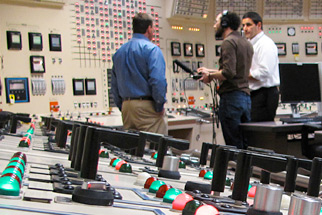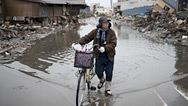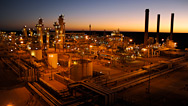Training for a Nuclear Crisis
- By David Levin
- Posted 03.29.11
- NOVA
Are workers at U.S. nuclear power plants fully prepared to deal with emergencies triggered by natural disasters? To find out, we visited the training center for Pilgrim Nuclear Power Station. Pilgrim is on the Atlantic coast near Plymouth, Massachussets, about an hour's drive south of Boston. It's one of 23 nuclear plants in the U.S. that use the same nuclear reactor design as the Fukushima Daiichi plant in Japan.
 Listen
Listen
Are workers at U.S. nuclear power plants prepared to deal with earthquakes, tsunamis, and other disasters?
Transcript
Training for a Nuclear Crisis
Posted March 29, 2011
DAVID LEVIN: You're listening to a NOVA podcast. I'm David Levin.
Right now, some 50 engineers are risking their lives to keep Japan's crippled nuclear reactors under control. It's a grim reminder of the dire consequences of a nuclear accident.
Are workers at U.S. power plants prepared to deal with emergencies like these? To find out, we visited the training center for Pilgrim Nuclear Power Station. Pilgrim is on the Atlantic coast near Plymouth, Massachussets, about hour's drive south of Boston. It's one of 23 nuclear plants in the U.S. that use the same design as the Fukushima Daiichi plant in Japan.
Randy Haislet has been working at Pilgrim for 25 years. He makes nuclear power sound simple.
RANDY HAISLET: It's a big steam pot. We produce steam. And that steam goes off to supply what every power plant has: a generator and a turbine that produces electrical power. We don't use fuel oil, we use nuclear power. So it's just a different source of heat.
DAVID LEVIN: But as straightforward as that seems, running a nuclear plant is incredibly complex. There's a lot that can go wrong. The fact that Pilgrim uses the same reactor as the plant in Japan has a lot of people in the Boston area worried. But Haislet thinks his colleagues can handle any emergency.
Like other nuclear plants, Pilgrim has a whole building dedicated just to training its operators. That's where Haislet works, along with Steve Reininghaus, director of training at Pilgrim. He says that getting certified as a plant operator is not easy.
STEVE REININGHAUS: You know, not everybody makes it. The training program is so rigorous and so intensive that there's a number of folks that just don't make it through the program. It's 14-18 months of better than 40 hours a week. And that—you're coming in with some level of training just to get to that point.
DAVID LEVIN: Once the operators are licensed, they spend one out of every eight weeks back in training. That's 240 hours a year. Nearly half of that time is spent running emergency drills in a life-size simulator of the plant's control room. It's filled with knobs, switches, dials, and flashing lights. And it looks exactly like the real thing.
AL MUSE: The paint color, the trash cans—the trash cans match the trash cans in the control room, and they're in the same location as the control room. So we want the individual to perform the same way in here as he's going to perform at the station.
DAVID LEVIN: Al Muse manages instructors at Pilgrim.
AL MUSE: the same operating crews that are operating the plant together operate the simulator together. And we do that such that we build teamwork amongst all the members of the team, so at any given point, if someone has difficulty, another team member would help them out.
STEVE REININGHAUS: I mean, just like in an airline cockpit, where you have a captain, and a copilot and a like a navigator, potentially, they all have very specific roles, but they function as a team.
DAVID LEVIN: Again, Steve Reininghaus.
He says there are 4-6 people in each crew. Having multiple eyes on the controls means that operators are more likely to catch a problem before it becomes dangerous.
STEVE REININGHAUS: We generally know very quickly that something is amiss. The amount of parameters that are monitored in the plant, if anything goes off normal, almost instantaneously we will see something.
DAVID LEVIN: If an alarm does go off, operators reach for a set of detailed checklists that help them respond to problems. They're kept in fat binders on a bookshelf in the simulator. There are hundreds of lists, but operators are trained to know exactly which one to reach for.
STEVE REININGHAUS: These alarm response procedures will be almost like when you see 'em on TV, like the pilot's gonna land the plane, they say, "take out the landing checklist." That's exactly what the operators will do in there. When they get this alarm, they pull out this checklist, and they're going, tick, tick tick, going off of the steps, and getting directed from the supervision in the control room.
DAVID LEVIN: It sounds something like this:
[alarm sounds]
RANDY HAISLET: Dave! We've had a trip of Alpha CRD pump.
DAVE NOYES: Randy, you've got a trip of CRD pump Alpha.
RANDY HAISLET: That is correct.
DAVE NOYES: Randy, execute procedure 244.
RANDY HAISLET: Understand enter and execute procedure 244. Al, check the immediate actions, I'm going to close the CRD flow control valve...
DAVID LEVIN: What you're hearing is a simple drill that Reininghaus's team is running. It's all for a single malfunctioning pump. Plant operators practice hundreds of different scenarios like this.
STEVE REININGHAUS: There's many, many procedures that deal with all sorts of potential malfunctions, and we give the operators every opportunity to see all those things up front, and to have experienced them in the simulator on the rare chance that it might happen to them for real.
DAVID LEVIN: Reininghaus says that Operators at Pilgrim train for natural disasters that haven't happened in New England for decades—sometimes centuries. Things like earthquakes and tsunamis. Those monster waves have hit the East coast in the past.
DAVE TARANTINO: Well, lets not sensationalize this. The tsunamis that happened on the east coast have been much smaller than the tsunami that impacted Japan.
DAVID LEVIN: Dave Tarantino is spokesman for Pilgrim Station.
DAVE TARANTINO: As a matter of fact, the most recent one, which was up in Newfoundland, was not even felt here in Plymouth, although there was a small impact in the Carolinas.
DAVID LEVIN: That was back in 1929. The tsunami was caused by an underwater landslide in the Atlantic, and there's a possibility it could happen again. But Tarantino says the danger Pilgrim faces isn't nearly as bad as what plants in Japan have had to deal with.
DAVE TARANTINO: I think it's important to stress that there's a tremendous difference between the geology in the east coast of Japan and the east coast of the United States. We don't have the type of volcanic and seismic activity that they have in Japan. The largest earthquake ever recorded in New England was 6.0 on the Richter scale in 1755. Pilgrim was designed with a seismic event of 7.0 on the Richter scale. And storm surge of 18 feet. We've never even come close to any of those events.
DAVID LEVIN: That's true, so far. Being in New England, Pilgrim Station will probably never take the kind of beating that crippled the Fukushima Daiichi plant. The most extreme events it's faced have been winter storms and hurricanes.
When it comes to seismic activity, nuclear plants on the East coast don't have a lot to worry about. On the West coast, though, it's a different story.
There are two active nuclear plants in California right now, and both were built near fault lines. Granted, they were designed to handle big quakes, and each one has a simulator to train operators for worst-case scenarios.
Again, Randy Haislet.
RANDY HAISLET: You'd like to think that the training we're getting is sufficient to be able to handle those natural disasters. And of course we have got that ability to go ahead and train those types of activities, learn from those activities, and make sure that our crews here in the States can handle any type of situation that comes at them.
DAVID LEVIN: But the shattered reactor buildings in Japan are a reminder that nature can foil even the most careful preparation. It's too early to tell how the accident will affect the future of nuclear energy in the US, but you can bet that Haislet and the staff at Pilgrim will be watching.
For NOVA, I'm David Levin.
Credits
- Special thanks to Dave Noyes at Pilgrim Nuclear Power Station for providing additional information.
Audio
- Produced by
- David Levin
Image
- (control room)
- © WGBH Educational Foundation
Related Links
-

Inside a Nuclear Control Room
Explore a panoramic image of the control room at the Pilgrim Nuclear Power Station's training simulator.
-

Japan's Killer Quake
An eyewitness account and investigation of the epic earthquake, tsunami, and nuclear crisis
-

Nuclear After Japan
Amory Lovins and other experts reflect on what Japan's crisis may mean for the future of nuclear energy.
-

Power Surge
Are we finally on the brink of a clean energy revolution?
You need the Flash Player plug-in to view this content.

